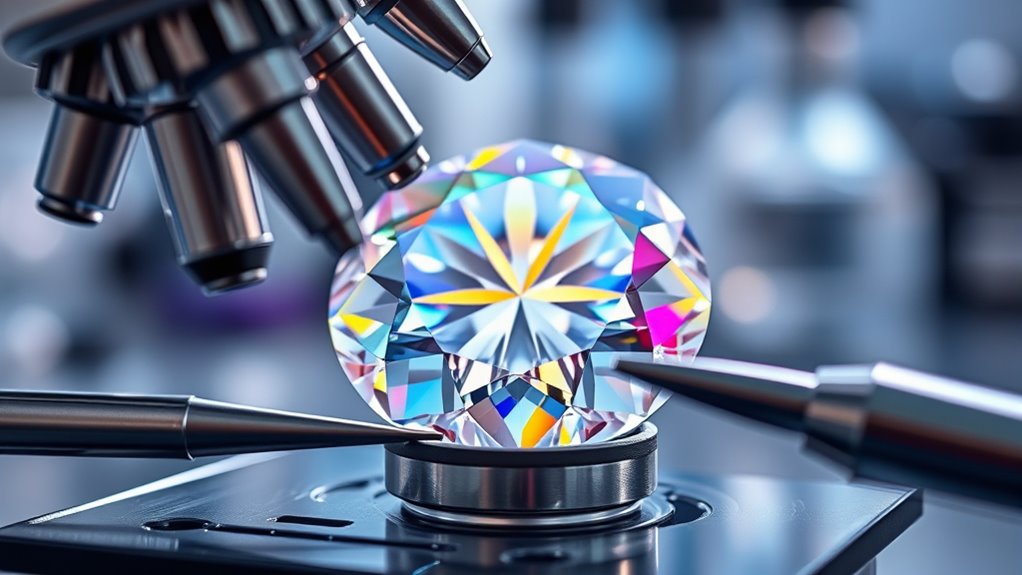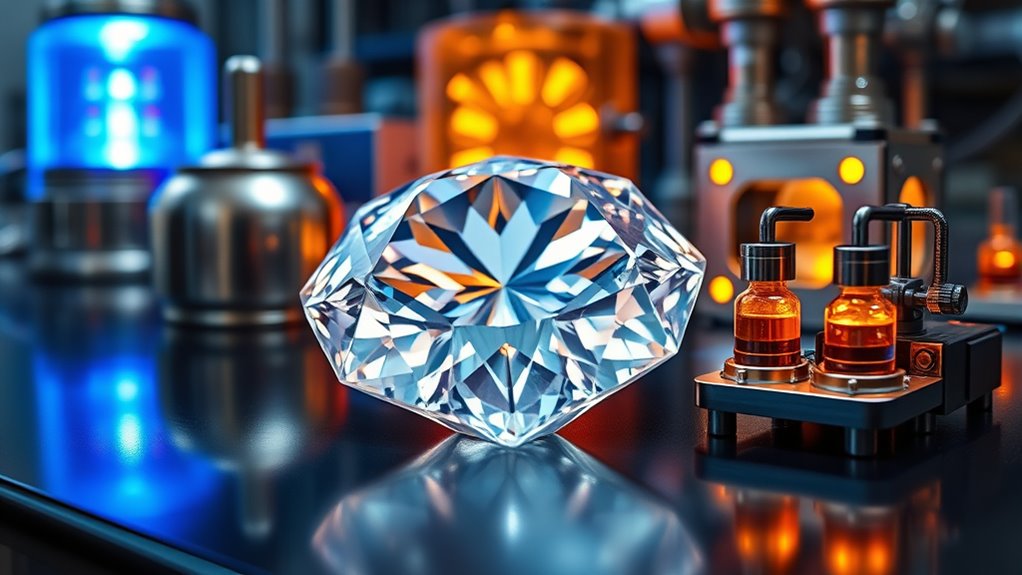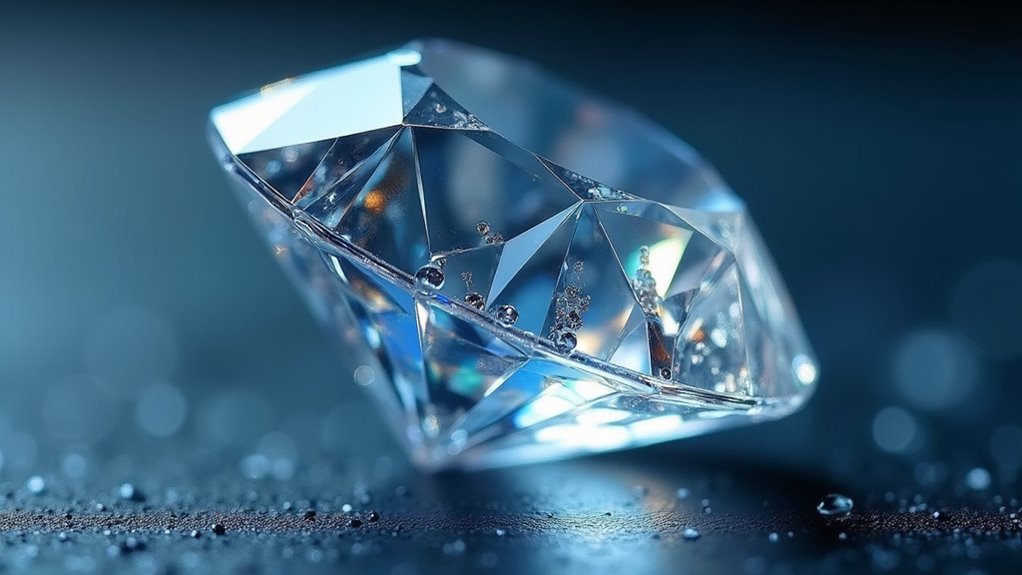Lab-grown diamonds are made through advanced chemical processes that replicate natural formation. Techniques like HPHT and CVD apply high heat, pressure, or carbon gas to create crystals with the same structure, composition, and brilliance as natural diamonds. The key is controlling carbon atoms to form a strong, transparent gemstone. If you want to discover more about the fascinating chemistry behind these stunning gems, keep exploring how science is shaping their future.
Key Takeaways
- Lab-grown diamonds form through controlled chemical processes that replicate natural high-pressure and high-temperature conditions.
- Both HPHT and CVD methods manipulate carbon atoms to create identical crystalline structures as natural diamonds.
- During CVD, carbon gas deposits layer by layer onto a substrate, building a diamond through chemical reactions.
- The strong covalent bonds between carbon atoms in lab-grown diamonds result from precise chemical and environmental control.
- Advanced chemistry techniques ensure consistent quality, color, and size in synthetic diamonds, matching their natural counterparts.
The Science Behind Lab-Grown Diamonds

Lab-grown diamonds are created through advanced technological processes that replicate the natural conditions under which diamonds form. You can produce them mainly using two methods: High-Pressure High-Temperature (HPHT) and Chemical Vapor Deposition (CVD). Both techniques involve manipulating carbon atoms to form crystalline structures identical to those in natural diamonds. In HPHT, carbon is subjected to extreme heat and pressure, mimicking Earth’s deep conditions. CVD, on the other hand, deposits carbon gas onto a substrate, gradually building a diamond crystal layer by layer. These processes allow for high control over the diamond’s quality, resulting in stones with superior clarity, strength, and electrical properties. The growth environment can be precisely controlled to customize the diamond’s properties, such as color and size, during production. Despite their similarities, these methods differ in cost, efficiency, and scalability, shaping the growing market for synthetic diamonds.
The Chemistry of Diamond Formation

The formation of diamonds hinges on the unique arrangement and bonding of carbon atoms within their crystal lattice. In diamonds, each carbon atom covalently bonds to four others in a tetrahedral pattern, creating an incredibly strong, rigid three-dimensional network. Diamonds are made of a single element: carbon. These bonds involve sharing electron pairs, with carbon atoms adopting an sp³ hybridization, which underpins the gemstone’s hardness and stability. High pressure—around 50,000 atmospheres—and temperatures between 1,200 and 1,600°C in the Earth’s mantle promote close atomic bonding, transforming other carbon forms like graphite into diamond. Fluids rich in carbon and other elements play a crucial role, enabling nucleation and growth through episodic deposition. This extreme chemistry ensures the stable, dense crystalline structure that makes diamonds so durable and prized as gemstones, with carbon-rich fluids facilitating the crystallization process.
Comparing Natural and Synthetic Diamonds

Both natural and synthetic diamonds share the same chemical makeup and physical properties, making them virtually identical in appearance and durability. They’re composed of pure carbon arranged in a crystal lattice, giving them the same hardness, brilliance, fire, and scintillation. Understanding their composition is key to recognizing their true similarity. Natural diamonds form over billions of years deep within the Earth, while lab-grown versions are produced in weeks or months through controlled processes that replicate natural conditions. Visually, they’re indistinguishable to the naked eye, but natural diamonds often contain unique inclusions formed over time, whereas synthetic ones tend to have fewer or different types of inclusions, like metallic ones. Advanced instruments can detect subtle differences, but for most purposes, both types look and perform the same, with certification confirming their origin. Moreover, advancements in merchant services have made it easier for consumers to verify and authenticate diamonds through secure digital platforms.
Advances in CVD and HPHT Technologies

Recent advances in CVD (Chemical Vapor Deposition) and HPHT (High Pressure High Temperature) technologies have remarkably improved the quality, size, and consistency of synthetic diamonds. HPHT replicates natural formation with extreme pressure and heat, producing smaller, high-quality stones with vivid colors, often enhanced through post-growth treatments. CVD builds diamonds layer-by-layer in low-pressure chambers, enabling larger stones over 5 carats with fewer metal inclusions and precise control over clarity and size. Both methods now benefit from energy-efficient designs, reducing costs and environmental impact. These improvements have expanded the range of possible gemstone qualities, making synthetic diamonds more versatile and desirable. The security of eSIM technology has also contributed to safer digital transactions and communication. The table below highlights key differences:
| Method | Growth Process | Typical Outcomes |
|---|---|---|
| HPHT | High pressure & heat | Small, vivid-colored diamonds |
| CVD | Layered gas deposition | Large, pure Type IIa diamonds |
| Hybrid | Combination approach | Optimized seed and growth |
The Future of Gem-Quality Lab-Grown Diamonds

Advancements in technology are shaping the future of gem-quality lab-grown diamonds, making them more sustainable, affordable, and versatile. Market growth is rapid, with projections reaching 20% of all diamonds by 2025 and annual growth rates around 22%. This expansion increases the availability of larger, higher-quality stones at competitive prices. Most lab-grown diamonds are produced via Chemical Vapor Deposition (CVD), which allows for precise control over growth conditions and quality. Innovations are also reducing environmental impacts by optimizing energy use and integrating renewable sources into production. Improvements in growth control enable consistent creation of diamonds with superior color and clarity, matching or exceeding natural standards. Consumer acceptance continues to grow, driven by value, ethics, and transparency. Future tech developments aim to further lower costs, improve quality, and expand design possibilities, solidifying lab-grown diamonds as a mainstream choice in jewelry and reshaping the global supply chain.
Frequently Asked Questions
Are Lab-Grown Diamonds Environmentally Sustainable Compared to Mined Diamonds?
You might wonder if lab-grown diamonds are more environmentally sustainable than mined ones. While they produce less habitat destruction and water use, their energy-intensive creation often relies on fossil fuels, increasing CO2 emissions.
However, using renewable energy can improve their sustainability. Overall, lab-grown diamonds have a smaller environmental footprint in some areas but still face challenges, especially regarding energy consumption and carbon emissions.
How Do Lab-Grown Diamonds Impact the Global Diamond Market?
You should know that the lab-grown diamond market grew from 3.5% in 2018 to over 18.5% in 2023, showing rapid expansion.
Their impact is significant: they lower prices of natural diamonds, increase market competition, and make jewelry more affordable.
As demand shifts, traditional mining faces challenges, and retailers adapt by balancing both natural and lab-grown stones, ultimately changing the landscape of the global diamond industry.
Can Lab-Grown Diamonds Be Distinguished From Natural Diamonds With the Naked Eye?
You can’t tell lab-grown diamonds from natural ones just by looking. They appear identical to the naked eye, especially when matched for color and clarity. Even experts struggle without specialized equipment.
The only subtle clue might be microscopic laser inscriptions. To truly distinguish them, you need advanced tools like spectroscopy or magnification.
What Are the Cost Differences Between Lab-Grown and Natural Diamonds?
You’ll find that lab-grown diamonds typically cost between 60% and 95% less than natural diamonds of similar quality.
For example, a 1-carat natural diamond can range from $2,500 to $9,000, while a comparable lab-grown one might be just $500 to $2,500.
Factors like certification, size, and market demand influence these differences, making lab-grown stones a budget-friendly choice with similar appearance and chemistry.
Are There Ethical Concerns Associated With Lab-Grown Diamond Production?
Are you worried about the ethics behind diamond production? Lab-grown diamonds generally address many concerns, like avoiding conflict zones, child labor, and unsafe working conditions. They’re produced in regulated environments, offering transparency and shorter supply chains.
However, some ethical issues remain, especially regarding energy use and environmental impact if fossil fuels power the process. Would you feel more confident choosing a lab-grown diamond knowing it’s ethically cleaner than mined alternatives?
Conclusion
You now see how chemistry transforms carbon into sparkling gemstones, much like a master chef turns simple ingredients into a gourmet dish. Lab-grown diamonds, with their advanced technologies, offer a sustainable and ethical alternative to natural stones. As science continues to refine these methods, you can expect even more dazzling, high-quality gems that rival their mined counterparts. It’s an exciting time, where chemistry’s magic creates beauty as effortlessly as a painter’s brush strokes on a canvas.









